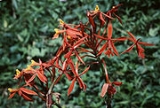
Epidendrum macrocarpum
Encyclopedia
Epidendrum macrocarpum, commonly known as Epidendrum schomburgkii, is a species of orchid in the genus Epidendrum
, and the largest-flowering crucifix orchid species. Reichenbach thought that E. fulgens
and E. schomburgkii var. confluens
were both synonyms for this species.
, and like other members of this subgenus, it exhibits a sympodial form of growth with un-swollen stems covered by the close, imbricating distichous sheathes, which are leaf bearing above, and a peduncle
covered from its base with close, imbricating sheathes. The stems of this epiphyte
grow to 1 m tall. The oblong obtuse fleshy leaves grow to 10 cm long by 2.5 wide. As with other members of E. sect. Schistochila
, the racemose
inflorescence bears many flowers with trilobate lips
. The flowers of E. macrocarpum are bright orange, resupinate, and large, measuring nearly 5 cm across. The narrow lanceolate acute sepals and petals are 25 mm long but only 5 mm wide. As with other members of E. subsect. Carinata
, the lobes of the lip are fringed, and there is a keel running down the midlobe.
Kunth (1816).
Epidendrum incisum Rchb.f. & Warsz. (1854) nom. illeg. is not a synonym for E. macrocarpum, but for Epidendrum secundum
Jacq (1760).
Epidendrum
Epidendrum , abbreviated Epi in horticultural trade, is a large neotropical genus of the orchid family. With more than 1,100 species, some authors describe it as a mega-genus. The genus name refers to its epiphytic growth habit...
, and the largest-flowering crucifix orchid species. Reichenbach thought that E. fulgens
Epidendrum fulgens
Epidendrum fulgens is a crucifix orchid native to Brazil. Like E. secundum, with which it has been found to hybridize in habitats disturbed by human activity, E. fulgens flowers are non-resupinate and are born in a congested racime at the end of a long spike...
and E. schomburgkii var. confluens
Epidendrum ibaguense
Epidendrum ibaguense is a species of epiphytic orchid of the genus Epidendrum which occurs in Trinidad, French Guyana, Venezuela, Colombia and Northern Brazil.There is a good article on this species in the Português Wikipedia...
were both synonyms for this species.
Description
E. macrocarpum has been placed (as E. schomburgkii) in the subgenus E. subg. AmphiglottiumEpidendrum subg. Amphiglottium
Epidendrum subg. Amphiglottium Lindl. 1841 is a subgenus of reed-stemmed Epidendrums, distinguished by an apical inflorescence with the peduncle covered from its base with close imbricating sheaths and by a lip that is adnate to the column to its apex.Reichenbach published three sections in this...
, and like other members of this subgenus, it exhibits a sympodial form of growth with un-swollen stems covered by the close, imbricating distichous sheathes, which are leaf bearing above, and a peduncle
Peduncle (botany)
In botany, a peduncle is a stem supporting an inflorescence, or after fecundation, an infructescence.The peduncle is a stem, usually green and without leaves, though sometimes colored or supporting small leaves...
covered from its base with close, imbricating sheathes. The stems of this epiphyte
Epiphyte
An epiphyte is a plant that grows upon another plant non-parasitically or sometimes upon some other object , derives its moisture and nutrients from the air and rain and sometimes from debris accumulating around it, and is found in the temperate zone and in the...
grow to 1 m tall. The oblong obtuse fleshy leaves grow to 10 cm long by 2.5 wide. As with other members of E. sect. Schistochila
Epidendrum sect. Schistochila
Epidendrum sect. Schistochila Rchb.f. is a section of the subgenus E. subg. Amphiglottium Lindl. of the Genus Epidendrum of the Orchidaceae...
, the racemose
Raceme
A raceme is a type of inflorescence that is unbranched and indeterminate and bears pedicellate flowers — flowers having short floral stalks called pedicels — along the axis. In botany, axis means a shoot, in this case one bearing the flowers. In a raceme, the oldest flowers are borne...
inflorescence bears many flowers with trilobate lips
Labellum
Labellum is the Latin diminutive of labium, meaning lip. These are anatomical terms used descriptively in biology, for example in Entomology and botany.-Botany:...
. The flowers of E. macrocarpum are bright orange, resupinate, and large, measuring nearly 5 cm across. The narrow lanceolate acute sepals and petals are 25 mm long but only 5 mm wide. As with other members of E. subsect. Carinata
Epidendrum subsect. Carinata
Epidendrum subsect. Carinata Rchb.f. is a subsection of the section E. sect. Schistochila Rchb.f. of the subgenus E. subg. Amphiglottium Lindl. of the genus Epidendrum of the Orchidaceae...
, the lobes of the lip are fringed, and there is a keel running down the midlobe.
Homophony
Epidendrum schomburgkii var. confluens Lindl. (1853) is a synonym for Epidendrum ibaguenseEpidendrum ibaguense
Epidendrum ibaguense is a species of epiphytic orchid of the genus Epidendrum which occurs in Trinidad, French Guyana, Venezuela, Colombia and Northern Brazil.There is a good article on this species in the Português Wikipedia...
Kunth (1816).
Epidendrum incisum Rchb.f. & Warsz. (1854) nom. illeg. is not a synonym for E. macrocarpum, but for Epidendrum secundum
Epidendrum secundum
Epidendrum secundum, one of the crucifix orchids, is a poorly understood reed stemmed species, which Dressler describes as "the Epidendrum secundum complex." According to Dressler, there are dozens of varieties, some of which appear to deserve species rank...
Jacq (1760).

